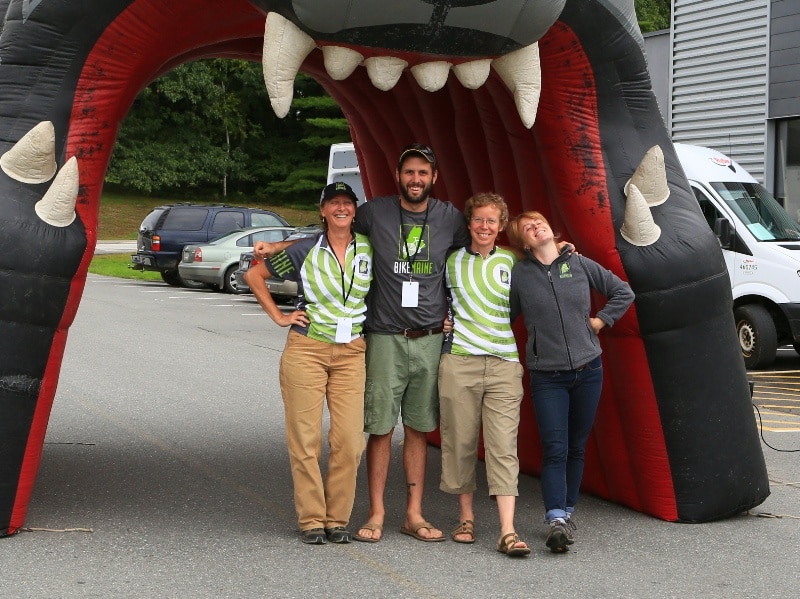
Kim True, BikeMaine’s first Ride Director, reflects on the challenges and rewards of crafting a bike tour out of thin air.
On Sunday, September 8, 2013, an excited crowd of of 251 bicyclists lined up in the Orono High School parking lot awaiting the start of the Inaugural BikeMaine. For more than two years, a Ride Committee appointed by the Bicycle Coalition of Maine had been working feverishly to build a bicycle event that would be fun for its riders, inject money into the local economy, and promote the benefits of bicycling to the greater public. BCM also expected that the event be profitable in three years, with proceeds divided between the organization and a grants program to improve walking and biking infrastructure in communities that hosted BikeMaine.
The Ride Committee began in November 2011 by developing its concept of a weeklong bicycle tour of Maine. The route, to be changed each year, was to be on quiet back roads and through small communities that traditionally did not see many tourists, but which offered stunning vistas and points of interest. Each route would also include one “marquee” community that could aid in marketing the event, and the first marquee town was to be Bar Harbor. The event would be held between Labor Day and peak foliage season, when traffic on the back roads is relatively light and the Maine harvest is at its peak. The committee settled on the event name, BikeMaine, and a tagline: “a rolling celebration of Maine’s people, places, culture and food.”
With a draft business plan and budget in hand, the committee began applying for funding to cover the costs of getting BikeMaine up and running. Within a few months, it secured $134,000 in grants from the Maine Office of Tourism and several major foundations. Ride Committee members assumed responsibility for different components of the event: developing the BikeMaine branding; building a website; selecting the host communities; creating a route; preparing communities for hosting BikeMaine; figuring out how and what to feed more than 300 people over the course of the week; finding the scores of volunteers needed each day to set up and take down the BikeMaine Village, prepare and serve meals, and monitor the route; arranging nightly entertainment; securing sponsorships; and attracting riders who would pay $900 to ride approximately 400 miles — rain or shine – over hilly terrain, sleep in tents, and trust an unproven crew to keep them safe and well fed for an entire week.
Regardless of whether one was a rider or a member of the organizing team, it took an act of courage to be at the BikeMaine start line in Orono on that early Sunday morning. Riders wondered if they and their bicycles would hold up for the week, and organizers wondered if plans would go off without a hitch. Everyone worried about the weather. After a series of short speeches, the green satin ribbon stretching across the parking lot was cut, signaling the start of BikeMaine. As music blared from the PA system and well wishers cheered, an Orono police car, with its siren blaring and blue lights flashing, led the cyclists out the parking lot, through the streets and to the entrance to the university bikepath. Along the bikepath, photographers were waiting to take each cyclist’s picture as a keepsake, but the cyclists never appeared. The officer leading the bicyclists brought them to the bikeway entrance he used, not the one marked on the map, which resulted in the bicyclists bypassing the photographers altogether. Less than 15 minutes into the event and things already were off script. Other surprises followed.
In Dover-Foxcroft, where the riders were to spend the first night en route, the BikeMaine advance team was busy setting up a new camping village. Although the team had planned extensively for rain, it had not sufficiently considered the effect of strong winds. The gusts that day were fierce; within the first hours they tore the BikeMaine pop up tents and forced the volunteers to take down 25 camping tents they had just set up and move them to a more protected area. The winds were so strong that they tipped porta potties, leaving event staff struggling to hold them upright until they could be staked.
In Bar Harbor, organizers learned that when a town says BikeMaine can set up camp on a baseball field but not on the adjacent soccer field, it may not have anything to do with the current sports season. The reason may be that one field, and not the other, serves as the landing spot for LifeFlight helicopters transporting patients needing emergency services at a nearby hospital. It’s worth noting that helicopter pilots are just as surprised as campers when landing a helicopter next to a field of tents at 4:00 a.m.
The biggest surprise of all that year was that, despite the mishaps and the cold, rainy weather for 6 of the 7 days, just about everyone involved with BikeMaine, as rider, organizer, volunteer, host community member, or spectator tracking the event on WCSH News, had a blast. Post-event surveys completed by the riders registered enthusiastic approval of the BikeMaine event and affirmed that Maine has much to offer bicycle tourists. It’s been clear from the first BikeMaine, and in every one thereafter, that something magical happens when people are brought together for a week of cycling through Maine, where the landscapes are beautiful, the food is incredible, and the communities are warm and welcoming. Bike on!